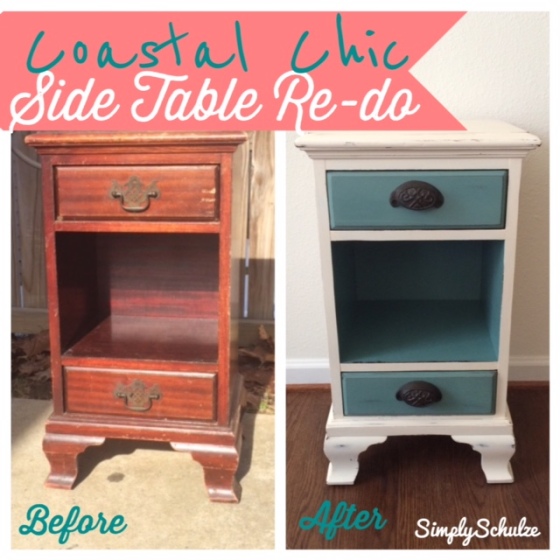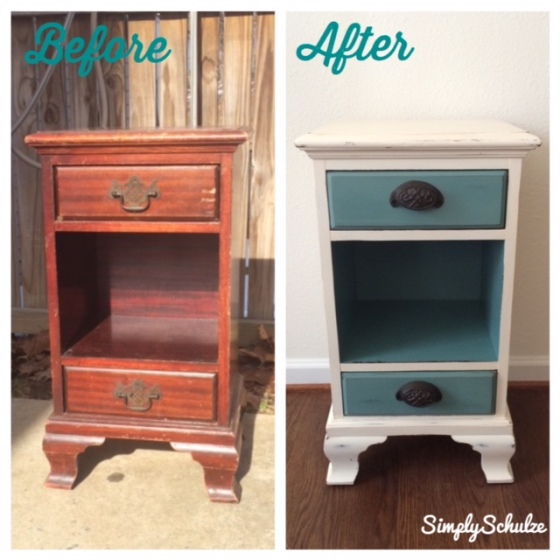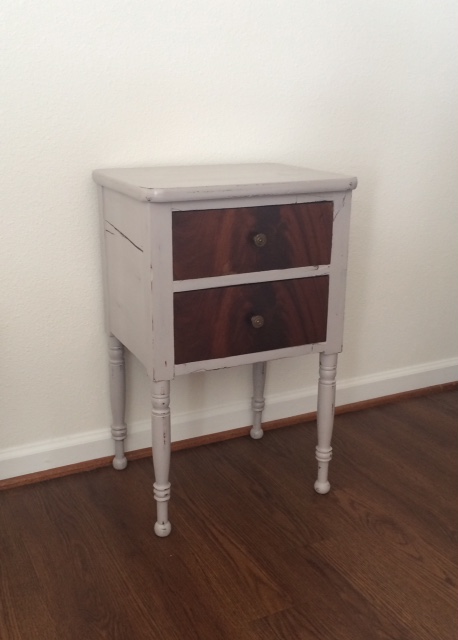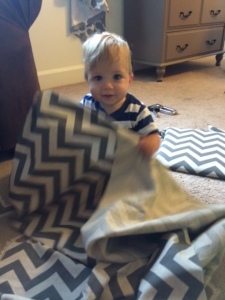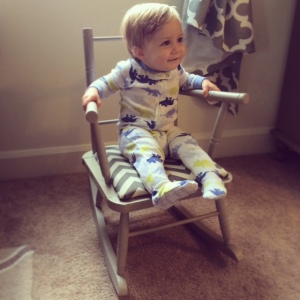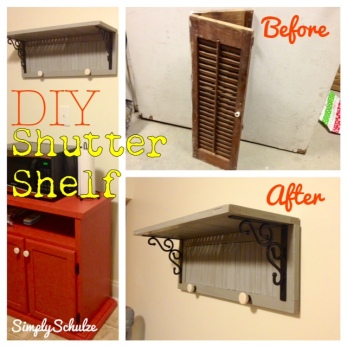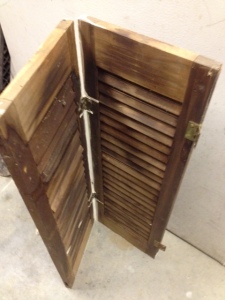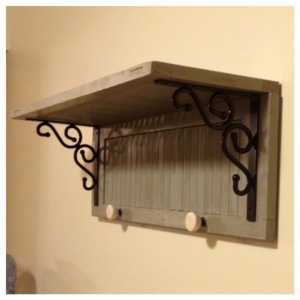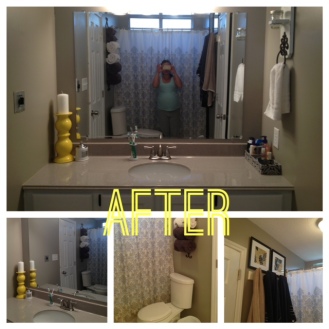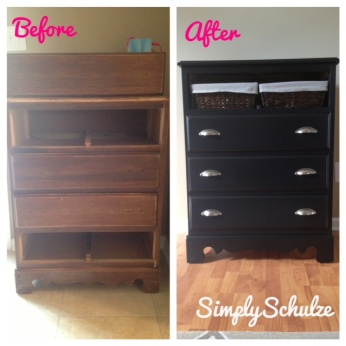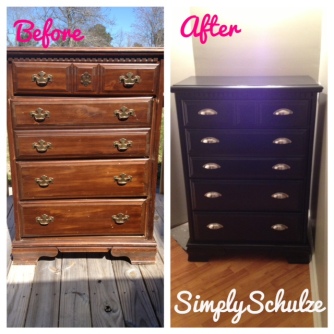
Some of my favorite projects have been my furniture re-dos. I love being able to see the finished product sitting there in my house each day as if to say “oh, hey lady, good morning, remember when you made me for $30? Yea, you’re awesome!” lol. My interest in refurbishing furniture was sparked by our move to our house here in Jacksonville. Up until then we had been living in a one bedroom condo with little need for much more furniture than the few IKEA pieces we’d purchased when we moved in. Suddenly we found ourselves living in about triple the square footage with our tiny condo’s worth of furniture at hand. Having seen a few things on Pinterest, I figured I’d give these re-dos a try. So I hopped on Lejeune Yard Sales (our local version of Craigslist) and found a few pieces for a few bucks and an obsession was born, haha.
Now I consider myself a novice furniture re-doer (is that a word? oh, well lol), I won’t say expert because I’m sure there are actually experts out there that will read this and cringe at my use of sub-par products and corner-cutting techniques, which brings me to my next point. My goal from the beginning has been to re-do my pieces on a budget, so I try to use products that are readily available at local home improvement stores at a low price point. Should I ever decide to re-do furniture for resale I would consider more expensive products, however, until that day my ways have worked for me and I’m sticking to ’em! Here are some of my favorite products (in no particular order) that I’ve used on many of my projects and while some are rather obvious, it will be easier to refer to this list when posting individual tutorials.
1. SANDING BLOCKS – I don’t to a ton of sanding on my pieces, just rough them up a bit and try to get any existing varnish dulled down. If you’re just looking to re-do an old piece you purchased for a few bucks or looking to upgrade and existing piece of old furniture, you probably don’t want to invest in an electric sander that you’ll probably use once. I happen to own an electric sander but I HATE that it generates so much dust and I find that sanding by hand has been fine in terms of how well my pieces have held up. These sanding blocks are easy to grip and great for giving a quick sand with even pressure as opposed to regular sheets of sand paper. I usually buy a 6-pack of 100-150 grit at Walmart or Lowes for about $6 (I found a 3-Pack here on Amazon for $7.30), tthese are great because they are reusable so a few will last you a few projects.

2. WOOD FILLER – This won’t be necessary for every piece, but for instance if your dresser comes with some weird metal piece that you’d like to pop off before you paint, this will fill the holes left behind. Additionally if your piece has any damage to it, such as deep cracks, dents in the wood or imperfections that can’t be fixed with sanding, this will do the trick. If you want to get supper crafty and change a two-pull dresser to a single knob just fill in the old holes with wood filler and drill new holes. Once you paint over it you will never know there was a hole or ding! Also, this tube is cheap and will last for many projects (I think I’ve been using the same tube for a year – impressive!!! lol). I usually go with the “natural” color, but it doesn’t matter what you choose as long as it’s paintable.

3. GENERAL FINISHES GEL STAIN – This stuff is awesome! It is technically a stain but goes on like paint. I originally used General Finishes which I purchased here on Amazon after seeing a tutorial recommending this particular brand (pictured below is my before and after of the dresser I re-did for P’s nursery and here is the tutorial). That being said I’d like to point out that recently Minwax has started making gel stain available in a variety of colors and is available at local home improvement stores, if you’d prefer to just buy it in-store as opposed to online. I prefer gel stain to regular stain because of the simple fact that it is so easy to work with. Regular stain is messy and requires a LOT of prep work and sanding which I am just too lazy for lol. That aside, I think that the gel stain gives it a more modern look. I also love the gel clear satin top coat (also available here on Amazon), it’s a little pricey but well worth it, when stored correctly a pint will last you MANY projects. NOTE: These GF products are not low VOC meaning that you will require lots of ventilation while doing your projects, no shutting yourself inside your garage for hours on end in the dead of winter, you need mask on, fans going and windows open! That being said breathing the stuff for a bit won’t kill you or but if zero or low VOC or eco-friendly paint is important to you please disregard this product recommendation.



4. FOAM BRUSHES – Okay this is kind of an obvious one lol but painting furniture with regular paint brushes will leave brush strokes. These foam brushes will put on a nice even coat of paint are easy to work with. Best of all they are SUPER cheap so you can buy a bunch and don’t have to worry about cleaning them in between coats, just chuck it and use a new one when you return to the project later. I have also used 4″ foam rollers designed for painting cabinets but only because I already had them from my cabinet re-do, it wouldn’t really be cost effective to buy a small roller set just for a dresser or what-have-you since you will still end up needing foam brushes for the corners, edges and grooves. Like I was saying, I always keep a ton of these foam brushes on hand since I end up using them on so many crafting projects, I purchase the 2″ ones at either Lowes ($0.79 ea) or Walmart ($0.47 ea).
5. BONDING PRIMER – This product comes in SUPER handy when refinishing laminate or fiberboard furniture. That being said, when possible try to stick to refinishing solid wood furniture, the finished product is much more durable and looks a lot nicer, BUT if you already have something lying around that you want to spruce up or happen to come across something for super cheap like I have, go nuts! Since you can’t sand fake wood, this bonding primer helps whatever paint you use adhere to the piece with minimal chipping (we hope, lol). The brands I use are Zinsser and Kilz but there are tons out there, as long as it is labeled “bonding primer” you’re good to go. Good thing is, you’ll only require one coat of this so a quart will last you a few projects. Check out my tutorial for re-doing laminate pieces here. NOTE: This is also some powerful stuff, it is oil-based so it can be messy and SUPER strong in the fumes department so be sure to keep those windows open! For a few more bucks, I think Lowes now offers an “odorless” version.


6. SAMPLE SIZE LATEX PAINT – If I was listing these in order of favorites, this would be number one. I know that there are tons of tutorials out there using chalk paint and furniture wax and while the finished products are beautiful, I am yet to try it. Latex paint has worked great for me, it’s cheap and I’ve found that as long as you have a solid piece of furniture and/or a good top coat it will be just as durable. I started becoming obsessed with these sample-size paints after I redid the dresser for P’s room using the java gel stain. I ended up using not even an eight of a quart and didn’t plan on using it for any other furniture in the foreseeable future (I’m pretty sure it’s still sitting in my garage and is most likely a solid block by now lol). In the interest of not wasting money like that on my next piece, I went to Lowes and instead of purchasing a quart of paint in my desired color, I had them tint an 8oz sample size (see below). Get ready to have your money-saving mind blow – it cost $2.98 (say whaaaaaaaat?!!?), I thought to myself “why you no think of this soon stooooopid???” haha. The truth is, for a lot of pieces, you’ll find that even with this tiny sample size you’ll have a ton left over. Be sure to keep it, they’re great for other craft projects! NOTE: Unfortunately, these little samples are only available in satin finish which is not ideal for furniture (a flat paint would adhere better), however, my pieces look great and I haven’t experienced any chipping so I guess it’s not that big of a deal.



7. POLYACRYLIC TOP COAT – This is a great top coat, it holds up well but is water-based so it’s a good alternative to a heavy oil-based top coat. I have used this on many of my pieces. If the piece is more for looks and isn’t going to experience a lot of bumps and day-to-day wear and tear (I used this on my chalk board frame and the little make-shift bathroom pedestal), I always opt for this product because it is easier to work with and requires less dry time than the oil based gel top coat. I usually purchase the satin finish because I prefer my pieces not to look super shiny, but if you’re piece is going to be touched and need to be wiped down a lot a gloss finish may be better suited to your project.

8. PLASTIC DROP CLOTHS – Here in NC our weather is not too conducive to painting outside, as most of the seasons have one factor or another that will make it pretty difficult (spring – rain, winter -cold, summer -humid etc.). Since multiple coats and a lot of drying time is required for furniture, the chance of you getting a solid 12-24 hours where there is no rain, the temperature is favorable and there is no wind to blow debris or bugs onto your project is pretty much none, haha. Additionally the fluctuating temperature makes it hard for me to paint in my garage since the temp in the garage is pretty much always the same as it is outdoors. Taking this into consideration I do all of my furniture painting projects in my living room or office on a big plastic drop cloth and even though my house will look like a project-zone for a few days it is well worth the finished product! I prefer plastic to canvas drop clothes because I am always paranoid that spilled paint or stain will seep through the cloth and onto the floor, which would not be the case with plastic. When I am finished I simply take it outside shake it out and fold it up to reuse for my next project!

